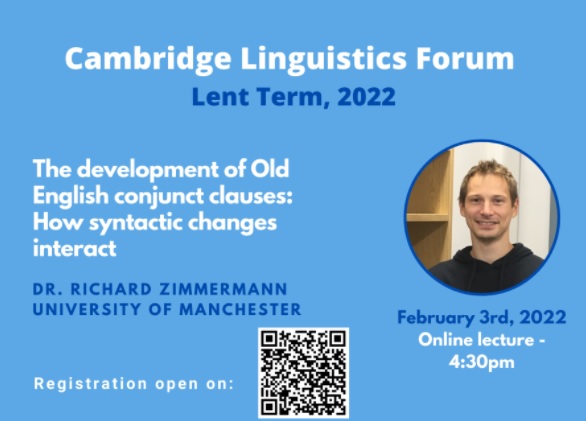Blog Post
12 Jan
2022
2022
Talk at The Cambridge Linguistics Forum |
The Cambridge Linguistics Forum (CLF) has invited me to deliver a talk and I have thankfully accepted. The talk will take place on Thursday, 3 February 2022, 4:30pm. I am grateful for the opportunity.
You can register here to attend the talk if you're interested.
Abstract
Scholars of Old English commonly postulate two distinct types of root clauses: ordinary main clauses and so-called conjunct clauses, i.e. main clauses that are introduced by a coordinating conjunction, like and ‘and’, ac ‘but’, oþþe ‘or’ and ne ‘nor.’ These two clause types are distinct in terms of several word order patterns. The distributional word order differences are, however, merely statistical in nature.
Firstly, main clauses are far more likely to show the finite verb in medial position similar to Modern English, than conjunct clauses, which retain a conservative verb-final pattern more frequently.
Secondly, topicalization, constituent fronting to clause-initial position, occurs frequently in main clauses, whereas such structures are uncommon in conjunct clauses.
These facts can be formalized as follows: A structurally high phrase, CP, places a complementizer in its head position, C°, leading to frequent verb-final subordinate clauses, and optionally projects a fronted constituent in its specifier, leading to topicalization structures. One can then assume that Old English has a very special class of conjunctions, which can occur under C°. I call those items ‘C-head conjunctions’. This captures the higher rates of verb-final headedness and the lower rates of topicalization in conjunct clauses at the same time.
This theory leads to expected violations of the Constant Rate Effect. These violations are among the first theoretically predicted interactions between syntactic changes, and are therefore the focus of this presentation.
First, verb final orders are in the process of disappearing. The loss of C-head conjunctions should open up the C° position for the finite verb, thereby speeding up this change in conjunct clauses. Second, topicalization becomes less common. The loss of C-head conjunctions should compensate for this reduction to some degree, thus slowing down the change in conjunct clauses. Both of these predictions are born out.
I'm looking forward to the event :)
Copyright © 2020 - 2024 www.RichardZimmermann.com
